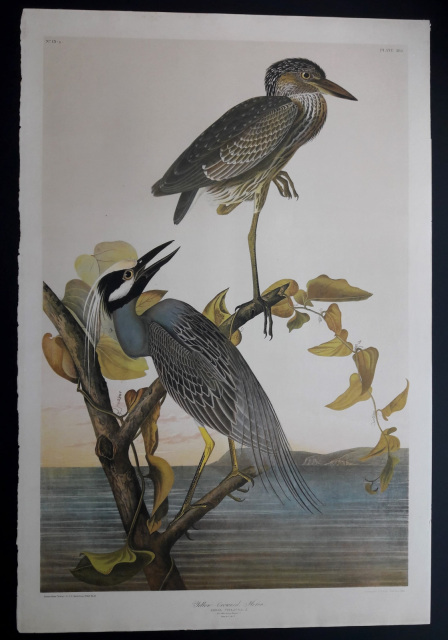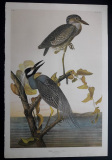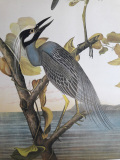- Home
- >
- Audubon's Bien Edition Birds (19th Century)
- >
- 364 - Yellow-crowned Heron
364 - Yellow-crowned Heron
SKU:
BE-364
$24,000.00
$19,000.00
$19,000.00
Unavailable
per item
Chromolithy by J. Bien, New York. Painted by Audubon in 1831 in Charleston, SC. One of the most beautiful compositions by Audubon that captures the adult and immature birds in their splendid plumage, resting on a tree against a backdrop of an evening sunset over a sea with distant mountains. This is one of the examples where the Bien edition image actually looks prettier than its corresponding Havell edition print.
Audubon wrote: "This species places its nest either high or low, according to the nature of the place selected for it, and the abundance of food in the neighbourhood. In the interior of swampy woods, in Lower Louisiana, I have found the nests placed on the tops of the loftiest cypresses, and on low bushes, but seldom so close together as those of many other Herons. On the Florida Keys, where I have examined more of these tenements than in any other part, I found them either on the tops of mangroves, which there seldom attain a greater height than twenty-five feet, or on their lowest branches, and not more than two or three feet from the water. In the Carolinas, they usually resort to swamps, nestling on the bushes along their margins. The nest is similar to that of other Herons, being formed of dry sticks loosely put together, and a few weeds, with at times a scanty lining of fibrous roots."
Audubon wrote: "This species places its nest either high or low, according to the nature of the place selected for it, and the abundance of food in the neighbourhood. In the interior of swampy woods, in Lower Louisiana, I have found the nests placed on the tops of the loftiest cypresses, and on low bushes, but seldom so close together as those of many other Herons. On the Florida Keys, where I have examined more of these tenements than in any other part, I found them either on the tops of mangroves, which there seldom attain a greater height than twenty-five feet, or on their lowest branches, and not more than two or three feet from the water. In the Carolinas, they usually resort to swamps, nestling on the bushes along their margins. The nest is similar to that of other Herons, being formed of dry sticks loosely put together, and a few weeds, with at times a scanty lining of fibrous roots."
364 - Yellow-crowned Heron
Chromolithograph
Bien Edition, Birds of America.
The Bien edition prints of the Birds of America were produced by the Audubon family (by Audubon’s sons John Woodhouse and Victor Gifford), and thus are properly termed originals. Unlike the Havell edition prints which were produced in England, the Bien Edition prints were produced completely in America. Thus, they are truly American originals. In 1858, about seven years after John James Audubon passed away, his younger son John Woodhouse Audubon initiated an ambitious project to reissue the Birds of America to solve some of the mounting financial problems. He recruited the Roe Lockwood Company in New York city to publish the works and Julius Bien for lithography. Unlike the Havells which were produced from copper engraving plates, Julius Bien utilized the newly emerging chromolithography process as a way of reducing the costs of production. Chromolithography utilized a set of printing stones (about 6 or more, carrying images transferred from the original copper-plate engravings), each with different color printed in register to layer the colors to produce the final colored image on paper. Some of the final prints were hand-colored in specific areas to enhance the image. The use of different stones occasionally resulted in very slight misregister of colors on the dark outlines of birds and background, thus serving as a charming reminder of chromolithography process. Larger images were printed on a single page as in the Havell edition, whereas smaller images were printed two per page. All the larger images as well as some smaller images carry the credit "Chromolithy by J. Bien, New York, 1860” (but some with years between 1858 to 1862). Thus these images are commonly referred to as the Bien edition plates. Unfortunately, the start of the Civil War in 1860 brought an abrupt end to this project (and a financial ruin to the Audubon family) after only about 105 pages were printed. It was said that about 100 copies of each page (with bird images) were produced, but most of them did not survive. The Bien edition prints are more scarce to find than the Havell edition prints. For an excellent introduction to the Bien edition, please see the books by Susanne M. Low and Bill Steiner (books listed in the page about John James Audubon).
(Copyright, April 14, 2005, by the owner of AntiqueAudubon.Com)
Most of the prints available in this gallery are full sheets (~ 39" x 26"). Slightly trimmed prints are indicated. Please ask for detailed condition report before purchasing.
Bien Edition, Birds of America.
The Bien edition prints of the Birds of America were produced by the Audubon family (by Audubon’s sons John Woodhouse and Victor Gifford), and thus are properly termed originals. Unlike the Havell edition prints which were produced in England, the Bien Edition prints were produced completely in America. Thus, they are truly American originals. In 1858, about seven years after John James Audubon passed away, his younger son John Woodhouse Audubon initiated an ambitious project to reissue the Birds of America to solve some of the mounting financial problems. He recruited the Roe Lockwood Company in New York city to publish the works and Julius Bien for lithography. Unlike the Havells which were produced from copper engraving plates, Julius Bien utilized the newly emerging chromolithography process as a way of reducing the costs of production. Chromolithography utilized a set of printing stones (about 6 or more, carrying images transferred from the original copper-plate engravings), each with different color printed in register to layer the colors to produce the final colored image on paper. Some of the final prints were hand-colored in specific areas to enhance the image. The use of different stones occasionally resulted in very slight misregister of colors on the dark outlines of birds and background, thus serving as a charming reminder of chromolithography process. Larger images were printed on a single page as in the Havell edition, whereas smaller images were printed two per page. All the larger images as well as some smaller images carry the credit "Chromolithy by J. Bien, New York, 1860” (but some with years between 1858 to 1862). Thus these images are commonly referred to as the Bien edition plates. Unfortunately, the start of the Civil War in 1860 brought an abrupt end to this project (and a financial ruin to the Audubon family) after only about 105 pages were printed. It was said that about 100 copies of each page (with bird images) were produced, but most of them did not survive. The Bien edition prints are more scarce to find than the Havell edition prints. For an excellent introduction to the Bien edition, please see the books by Susanne M. Low and Bill Steiner (books listed in the page about John James Audubon).
(Copyright, April 14, 2005, by the owner of AntiqueAudubon.Com)
Most of the prints available in this gallery are full sheets (~ 39" x 26"). Slightly trimmed prints are indicated. Please ask for detailed condition report before purchasing.





